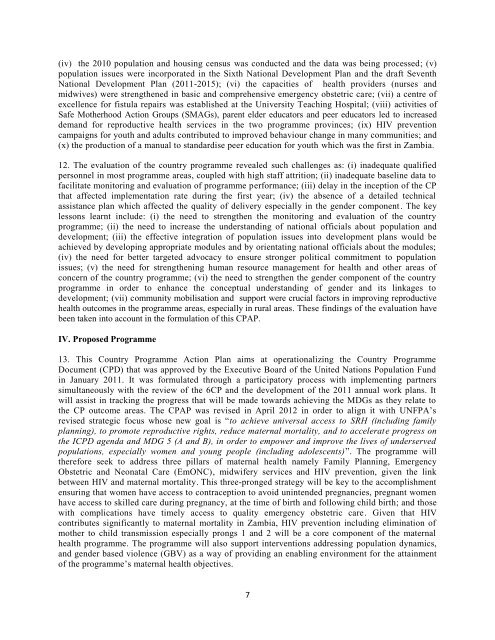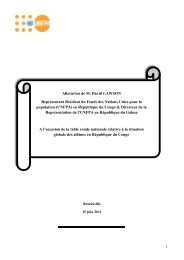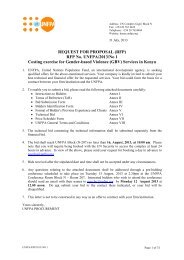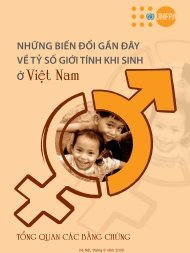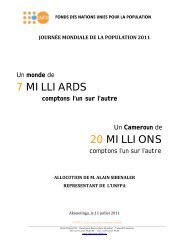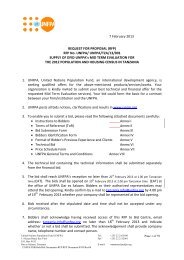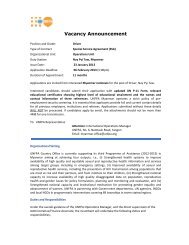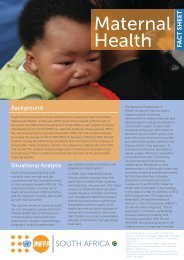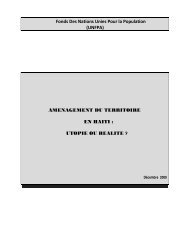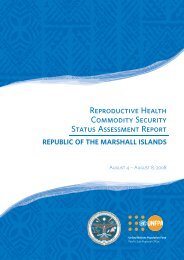GOVERNMENT OF THE REPUBLIC OF ZAMBIA (GRZ) And THE ...
GOVERNMENT OF THE REPUBLIC OF ZAMBIA (GRZ) And THE ...
GOVERNMENT OF THE REPUBLIC OF ZAMBIA (GRZ) And THE ...
Create successful ePaper yourself
Turn your PDF publications into a flip-book with our unique Google optimized e-Paper software.
(iv) the 2010 population and housing census was conducted and the data was being processed; (v)<br />
population issues were incorporated in the Sixth National Development Plan and the draft Seventh<br />
National Development Plan (2011-2015); (vi) the capacities of health providers (nurses and<br />
midwives) were strengthened in basic and comprehensive emergency obstetric care; (vii) a centre of<br />
excellence for fistula repairs was established at the University Teaching Hospital; (viii) activities of<br />
Safe Motherhood Action Groups (SMAGs), parent elder educators and peer educators led to increased<br />
demand for reproductive health services in the two programme provinces; (ix) HIV prevention<br />
campaigns for youth and adults contributed to improved behaviour change in many communities; and<br />
(x) the production of a manual to standardise peer education for youth which was the first in Zambia.<br />
12. The evaluation of the country programme revealed such challenges as: (i) inadequate qualified<br />
personnel in most programme areas, coupled with high staff attrition; (ii) inadequate baseline data to<br />
facilitate monitoring and evaluation of programme performance; (iii) delay in the inception of the CP<br />
that affected implementation rate during the first year; (iv) the absence of a detailed technical<br />
assistance plan which affected the quality of delivery especially in the gender component. The key<br />
lessons learnt include: (i) the need to strengthen the monitoring and evaluation of the country<br />
programme; (ii) the need to increase the understanding of national officials about population and<br />
development; (iii) the effective integration of population issues into development plans would be<br />
achieved by developing appropriate modules and by orientating national officials about the modules;<br />
(iv) the need for better targeted advocacy to ensure stronger political commitment to population<br />
issues; (v) the need for strengthening human resource management for health and other areas of<br />
concern of the country programme; (vi) the need to strengthen the gender component of the country<br />
programme in order to enhance the conceptual understanding of gender and its linkages to<br />
development; (vii) community mobilisation and support were crucial factors in improving reproductive<br />
health outcomes in the programme areas, especially in rural areas. These findings of the evaluation have<br />
been taken into account in the formulation of this CPAP.<br />
IV. Proposed Programme<br />
13. This Country Programme Action Plan aims at operationalizing the Country Programme<br />
Document (CPD) that was approved by the Executive Board of the United Nations Population Fund<br />
in January 2011. It was formulated through a participatory process with implementing partners<br />
simultaneously with the review of the 6CP and the development of the 2011 annual work plans. It<br />
will assist in tracking the progress that will be made towards achieving the MDGs as they relate to<br />
the CP outcome areas. The CPAP was revised in April 2012 in order to align it with UNFPA’s<br />
revised strategic focus whose new goal is “to achieve universal access to SRH (including family<br />
planning), to promote reproductive rights, reduce maternal mortality, and to accelerate progress on<br />
the ICPD agenda and MDG 5 (A and B), in order to empower and improve the lives of underserved<br />
populations, especially women and young people (including adolescents)”. The programme will<br />
therefore seek to address three pillars of maternal health namely Family Planning, Emergency<br />
Obstetric and Neonatal Care (EmONC), midwifery services and HIV prevention, given the link<br />
between HIV and maternal mortality. This three-pronged strategy will be key to the accomplishment<br />
ensuring that women have access to contraception to avoid unintended pregnancies, pregnant women<br />
have access to skilled care during pregnancy, at the time of birth and following child birth; and those<br />
with complications have timely access to quality emergency obstetric care. Given that HIV<br />
contributes significantly to maternal mortality in Zambia, HIV prevention including elimination of<br />
mother to child transmission especially prongs 1 and 2 will be a core component of the maternal<br />
health programme. The programme will also support interventions addressing population dynamics,<br />
and gender based violence (GBV) as a way of providing an enabling environment for the attainment<br />
of the programme’s maternal health objectives.<br />
7


